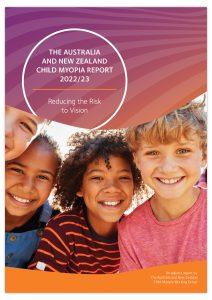1:30min
 The Australian and New Zealand Child Myopia Working Group has released a new report outlining the recommended Standard of Care for myopia management.
The Australian and New Zealand Child Myopia Working Group has released a new report outlining the recommended Standard of Care for myopia management.
The Child Myopia Working Group, made up of a collaboration of leading optometrists and ophthalmologists, was established in 2018 to deliver a recommended Standard of Care for the management of myopia in children with the aim of slowing its progression. The group has been enabled by CooperVision Australia & New Zealand.
 The released report, launched on 14 November, is titled ‘The Australian and New Zealand Child Myopia Report 2022/23 – Reducing the Risk to Vision’, and is an adjunct to the inaugural 2018 Childhood Myopia Report.
The released report, launched on 14 November, is titled ‘The Australian and New Zealand Child Myopia Report 2022/23 – Reducing the Risk to Vision’, and is an adjunct to the inaugural 2018 Childhood Myopia Report.
It presents the recommended best practice Standard of Care for myopia management and outlines what needs to be done to continue to manage and reduce its impact. It also provides evidence as to how myopia should be managed with intervention starting as soon as possible, and urges parents and carers to get their children’s eyes tested and, if diagnosed, have a discussion with an optometrist on how to best manage the condition.
In the report, the working group recommends a shift from not only correcting vision, but to also include a discussion between the optometrist and the parents and/or carers that explains what myopia is, lifestyle factors that may impact myopia, the increased risks to long-term ocular health myopia brings and available approaches that can be used to manage myopia and help slow its progression.
Dr Loren Rose, paediatric ophthalmologist and a founding member of the working group, said: ‘There is an urgent need for a greater focus on managing myopia and increasing awareness on the importance of children having regular eye examinations. By doing so, this will enable every child diagnosed with myopia to be managed with the recommended Standard of Care. A myopia management Standard of Care is critical, given that each year of delay in developing myopia substantially reduces the chance of a child developing high myopia in adulthood.’
New Zealand optometrist and fellow founding member of the working group, Jagrut Lallu adds: ‘For Australia and New Zealand, the forecast rate of myopia by 2050 is estimated to be 55% and we currently have an estimated 36% of the population affected. Furthermore, Australia is expected to have 4.1 million high myopes and New Zealand over 600,000 high myopes by 2050, unless myopia management is implemented by everyone. These forecasts highlight the scale of the problem that is facing the profession given Australia in 2020 had an estimated 1.1 million, and New Zealand over 200,000, high myopes.’
The recommended Standard of Care for myopia management
According to the report, for the practice setting, it is recommended that the following key elements should be included when managing a patient’s myopia:
- Use a myopia management program for patients with pre myopia or myopia based on the best available evidence.
- Explain to patients and their parents or carers what myopia is and discuss the increased risks to long term ocular health associated with myopia.
- Discuss, formulate, and implement an agreed management plan with the parent or carer and patient (child), including discussion of the evidence-based available myopia management options to mitigate axial length elongation; risks (lifestyle and family history) of myopia progression; provision of verbal and written information describing the risks and benefits of treatment, duration of treatment, review frequency, when to cease treatment and rebound effects.
- Document a review/recall for patients with myopia that demonstrate progression.
- Monitor the impact of treatment.
- Recognise personal limitations and refer patients to a suitable optometrist or ophthalmologist if the required myopia management services cannot be provided.
Optometry Australia President and fellow founding member of the Child Myopia Working Group, Margaret Lam said: ‘It’s important to be aware of the different management options available, because slowing the progression of myopia in children may prevent the development of high myopia. High myopia can cause serious eye health problems later in life.’
Optometrist members of the Child Myopia Working Group are Chair and Head of the School of Optometry and Vision Science, UNSW, Fiona Stapleton, Optometry Australia National President and Cornea and Contact Lens Society of New Zealand National President Margaret Lam, Optometry Australia Chief Clinical Officer Luke Arundel, Past President of the Cornea and Contact Lens Society of New Zealand Jagrut Lallu and Board member of The Orthokeratology Society of Oceania Andrew Sangster. Ophthalmologist members are paediatric ophthalmologist Dr Loren Rose from Australia and Dr Rasha Altaie from New Zealand.
Tagged as: Clinical practice guides, Paediatric optometry, Patient management